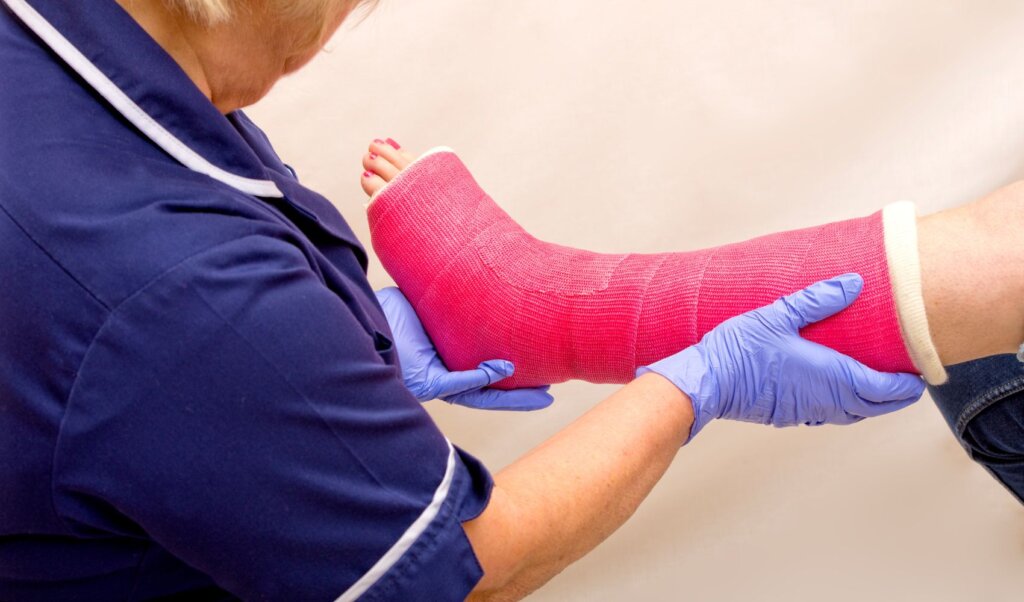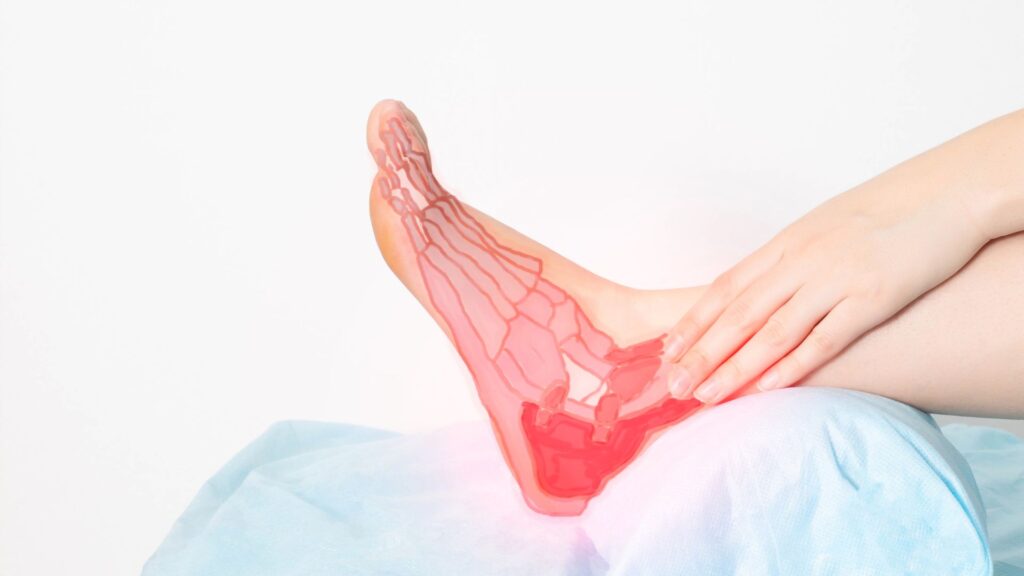About
The Anatomy of the Ankle
The ankle joint is a complex structure made up of three bones: the tibia, fibula, and talus. The tibia and fibula form the lower leg, while the talus is the bone that connects the leg to the foot. These bones are held together by a network of ligaments that provide stability and support.
Ankle Ligaments and Their Role
The ankle joint is a complex structure consisting of three bones: the tibia, fibula, and talus. These bones are held together by a network of ligaments that provide stability and support. Understanding the anatomy of the ankle ligaments is essential for grasping how ankle fractures occur and how they can be treated.
The ankle contains several key ligaments. These can be divided into two main groups: lateral ligaments and medial (or deltoid) ligament.
Lateral Ligaments
The lateral ligaments are found on the outer side of the ankle. Their main purpose is to stop the ankle joint from inverting too much. There are three main lateral ligaments:
- Anterior talofibular ligament (ATFL): The ATFL is the most commonly injured ankle ligament. It connects the talus bone to the fibula and helps prevent excessive forward motion of the talus on the tibia.
- Calcaneofibular ligament (CFL): The CFL runs from the fibula to the calcaneus (heel bone). This ligament provides stability to the subtalar joint and prevents excessive inversion of the ankle.
- Posterior talofibular ligament (PTFL): The PTFL connects the posterior aspect of the talus to the fibula and provides stability to the ankle joint, especially during dorsiflexion.
Medial Ligament (Deltoid Ligament)
The medial (or deltoid) ligament is a strong, fan-shaped ligament located on the inner side of the ankle. It is composed of four distinct parts that work together to provide stability and prevent excessive eversion of the ankle joint:
- Anterior tibiotalar ligament: This ligament connects the tibia to the talus and helps to stabilize the ankle joint during dorsiflexion.
- Tibiocalcaneal ligament: The tibiocalcaneal ligament runs from the tibia to the calcaneus and supports the medial aspect of the subtalar joint.
- Posterior tibiotalar ligament: This ligament connects the posterior aspect of the tibia to the talus and provides stability during plantarflexion.
- Tibionavicular ligament: The tibionavicular ligament connects the tibia to the navicular bone and helps to support the medial arch of the foot.
When an ankle fracture occurs, these ligaments can be injured or strained, causing instability in the joint. Diagnosis and treatment of ligament injuries are essential. This helps people to recover successfully and reduce their chances of chronic ankle instability or other issues.
The Mechanism of Ankle Fracture Injuries
Ankle fractures occur when one or more of these bones break or crack due to forceful impact or twisting. Common causes include sports injuries, falls, and car accidents. These fractures can range from simple breaks to complex injuries involving multiple bones and soft tissues.
Types of Ankle Fractures
There are several types of fractures that can occur in the ankle, including:
- Medial malleolus fracture: A break in the tibia’s inner portion
- Lateral malleolus fracture: A break in the fibula’s outer portion
- Posterior malleolus fracture: A break in the tibia’s rear portion
- Bimalleolar fracture: A fracture involving both the medial and lateral malleoli
- Trimalleolar fracture: A fracture involving all three malleoli
In addition to these, the Lauge-Hansen classification system categorizes ankle fractures based on the mechanism of injury and the resulting damage to the ankle joint.
Ligament Injuries: Ankle Sprains
Ankle injuries aren’t just about fractures; ligament injuries, or ankle sprains, also play a significant role. Let’s explore the two main types of ankle sprains: high ankle sprains and low ankle sprains.
High Ankle Sprain: A Rare Occurrence
High ankle sprains, or syndesmosis injuries, involve ligaments connecting the lower leg bones (tibia and fibula) and make up just 1-10% of all ankle sprains. These injuries are harder to diagnose and take longer to heal. Typically, they occur when the foot twists outward or the lower leg rotates inward while the foot is planted.
Low Ankle Sprain: The Common Culprit
Low ankle sprains are more common, accounting for over 90% of all ankle sprains. These injuries involve the lateral ligaments, primarily the anterior talofibular ligament (ATFL) and the calcaneofibular ligament (CFL). They usually happen when the foot rolls inward, causing excessive stress on the lateral ligaments.
Classifying Low Ankle Sprains: Grades I-III
Low ankle sprains are classified into three grades based on severity:
- Grade I: Mild injury with minimal ligament disruption and swelling, allowing patients to bear weight without significant pain.
- Grade II: Moderate injury with possible partial tearing, resulting in mild pain and a decreased range of motion.
- Grade III: Severe injury with complete ligament tears, causing severe pain and an unstable ankle joint.
Diagnosis
Recognising Ankle Fracture Symptoms and Signs
Common symptoms of an ankle fracture include:
- Severe pain
- Swelling
- Bruising
- Inability to bear weight on the affected leg
- Deformity of the ankle joint
If you suspect you have an ankle fracture, it’s crucial to seek medical attention promptly.
Examining and Diagnosing Ankle Fractures
A physical examination and X-ray are typically used to diagnose ankle fractures. In some cases, a CT scan may be necessary to assess the extent of the damage and plan appropriate treatment.
Treatment
Managing Ankle Fractures and Potential Complications
Ankle fracture treatment varies depending on the severity and type of fracture. Some fractures can be managed with a short leg cast or moon boot, while others may require surgical intervention with (https://www.sydneyorthopaedic.com.au/ankle-fractures.html). Early and appropriate treatment is crucial to minimize the risk of complications, such as infection, arthritis, and chronic pain.
Rehabilitation is a critical part of the recovery process, including physical therapy, which helps to restore range of motion and strength to the affected ankle.

Sarah’s Story: An Ankle Fracture Experience at Urgent Care Brisbane
Meet Sarah, a 35-year-old avid runner who was training for her first marathon. One day, while on a trail run, she stepped on an uneven surface and twisted her ankle. The pain was immediate, and she couldn’t put any weight on her foot. Sarah knew she needed urgent medical attention, but she wanted to avoid a long wait at the hospital emergency room.
Luckily, Sarah was able to get the help she needed at Urgent Care Brisbane. Upon arrival, she was seen by a qualified medical professional who quickly assessed her ankle. After a thorough examination and X-ray, it was determined that Sarah had a bimalleolar ankle fracture.
Urgent Care Brisbane was well-equipped to manage Sarah’s fracture. With on-site radiology, the team was able to perform a closed reduction, realigning the bones without surgery. Sarah’s ankle was then immobilized using a synthetic cast, and she was provided with crutches to help her stay mobile.
Over the following weeks, Sarah returned to Urgent Care Brisbane for follow-up appointments, where her healing progress was monitored. Once her fracture had healed sufficiently, the cast was removed, and she was given a moon boot to provide support and protection as she gradually began putting weight on her ankle again.
With the help of physiotherapy sessions, Sarah was able to regain her strength and mobility. She was grateful for the care she received at Urgent Care Brisbane and was able to avoid a lengthy and costly hospital stay.
Next Steps
How Urgent Care Brisbane Can Help You Manage Your Ankle Fracture
If you’ve fractured your ankle, Urgent Care Brisbane can help. They provide quick, top-notch care. This is similar to the situation Sarah faced. Their experienced team offers:
- On-site radiology for rapid diagnosis and assessment
- Closed reduction and casting for non-surgical fracture management
- Synthetic casts and moon boots for immobilization and support
- Availability of crutches to aid mobility
- Follow-up appointments to monitor healing progress
Don’t let an ankle fracture slow you down. Trust Urgent Care Brisbane to help you get back on your feet without the hassle of a hospital emergency room visit.

